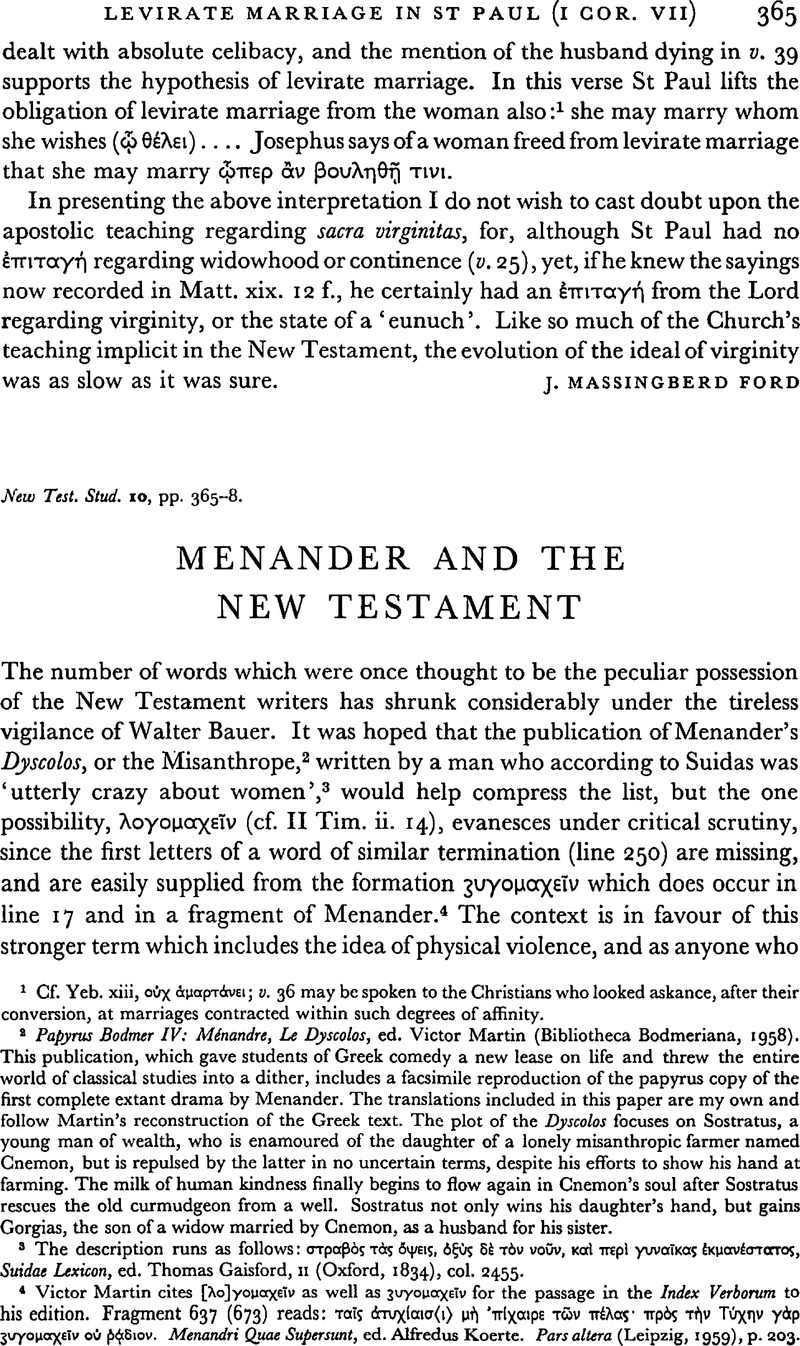Article contents
Menander and the New Testament
Published online by Cambridge University Press: 05 February 2009
Abstract

- Type
- Short Studies
- Information
- Copyright
- Copyright © Cambridge University Press 1964
References
page 365 note 1 Cf. Yeb. xiii, σύχ μαρτνεı v. 36 may be spoken to the Christians who looked askance, after their conversion, at marriages contracted within such degrees of affinity.
page 365 note 2 Papyrus Bodmer IV: Ménandre, Le Dyscolos, ed. Victor Martin (Bibliotheca Bodmeriana, 1958). This publication, which gave students of Greek comedy a new lease on life and threw the entire world of classical studies into a dither, includes a facsimile reproduction of the papyrus copy of the first complete extant drama by Menander. The translations included in this paper are my own and follow Martin's reconstruction of the Greek text. The plot of the Dyscolos focuses on Sostratus, a young man of wealth, who is enamoured of the daughter of a lonely misanthropic farmer named Cnemon, but is repulsed by the latter in no uncertain terms, despite his efforts to show his hand at farming. The milk of human kindness finally begins to flow again in Cnemon's soul after Sostratus rescues the old curmudgeon from a well. Sostratus not only wins his daughter's hand, but gains Gorgias, the son of a widow married by Cnemon, as a husband for his sister.
page 365 note 3 The description runs as follows: στραβς τς ðψεıς, ξὺς δ τν ![]() , καί περί γυναīκας
, καί περί γυναīκας ![]() , Suidae Lexicon, ed. Thomas Gaisford, II (Oxford, 1834), col. 2455.
, Suidae Lexicon, ed. Thomas Gaisford, II (Oxford, 1834), col. 2455.
page 365 note 4 Victor Martin cites [λο]γομαχεĩν as well as ![]() for the passage in the Index Verborum to his edition. Fragment 637 (673) reads: ταĩς
for the passage in the Index Verborum to his edition. Fragment 637 (673) reads: ταĩς ![]() μ πíχαıρε
μ πíχαıρε![]() πλας πρς τν τύχην γρ
πλας πρς τν τύχην γρ ![]()
![]()
![]() . Menandri Quae Supersunt, ed. Alfredus Koerte. Pars altera (Leipzig, 1959), p. 2O3.
. Menandri Quae Supersunt, ed. Alfredus Koerte. Pars altera (Leipzig, 1959), p. 2O3.
page 366 note 1 Danker, Frederick W., ‘The υ│ς Phrases in the New Testament’, N.T.S. VII (October, 1960), 94.Google Scholar
page 366 note 2 Wetstein, J., Novum Testamentum Graecum, II (Amsterdam, 1752 [Reprint, Graz, 1962]), 709.Google Scholar
page 366 note 3 Tindall, Christian, Contributions to the Statistical Study of the Codex Sinaiticus (Edinburgh and London, 1961), p. 10.Google Scholar
page 367 note 1 ‘Eagerness’, The Twentieth Century New Testament, Goodspeed, R.S.V., Confraternity (1947), Vulgate (cum omni aviditate), N.E.B.; ‘all readiness of mind’, A.S.V., R.V.; ‘most heartily welcomed’, Berkeley; ‘perfectly ready to receive the Word’, Moffatt; ‘ganz williglich’, Luther.Google Scholar
page 367 note 2 Cf. Liddell and Scott (Rev. ed., Jones-McKenzie), S.V. II.
page 367 note 3 Arndt-Gingrich associates the meanings ‘willingness, readiness, good-will’ with II Cor. viii. 12, 19, ix. 2 and Acts xvii. II.
- 1
- Cited by


